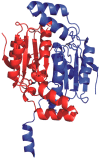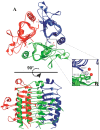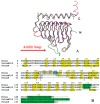Thermostable Carbonic Anhydrases in Biotechnological Applications
- PMID: 26184158
- PMCID: PMC4519908
- DOI: 10.3390/ijms160715456
Thermostable Carbonic Anhydrases in Biotechnological Applications
Abstract
Carbonic anhydrases are ubiquitous metallo-enzymes which catalyze the reversible hydration of carbon dioxide in bicarbonate ions and protons. Recent years have seen an increasing interest in the utilization of these enzymes in CO2 capture and storage processes. However, since this use is greatly limited by the harsh conditions required in these processes, the employment of thermostable enzymes, both those isolated by thermophilic organisms and those obtained by protein engineering techniques, represents an interesting possibility. In this review we will provide an extensive description of the thermostable carbonic anhydrases so far reported and the main processes in which these enzymes have found an application.
Keywords: CO2 capture process; carbonic anhydrases; protein engineering; thermostable enzyme.
Figures










References
-
- Figueroa J.D., Fout T., Plasynski S., McIlvried H., Srivastava R.D. Advances in CO2 capture technology—The U.S. department of energy’s carbon sequestration program. Int. J. Greenh. Gas Control. 2008;2:9–20. doi: 10.1016/S1750-5836(07)00094-1. - DOI
-
- Rayalu S., Yadav R., Wanjari S., Prabhu C., Mushnoori S.C., Labhsetwar N., Satyanarayanan T., Kotwal S., Wate S.R., Hong S.-G., et al. Nanobiocatalysts for carbon capture, sequestration and valorisation. Top. Catal. 2012;55:1217–1230. doi: 10.1007/s11244-012-9896-x. - DOI
-
- Shekh A.Y., Krishnamurthi K., Mudliar S.N., Yadav R.R., Fulke A.B., Devi S.S., Chakrabarti T. Recent advancements in carbonic anhydrase-driven processes for CO2 sequestration: Minireview. Crit. Rev. Environ. Sci. Technol. 2012;42:1419–1440. doi: 10.1080/10643389.2011.556884. - DOI
-
- Benson S.M., Surles T. Carbon dioxide capture and storage: An overview with emphasis on capture and storage in deep geological formations. Proc. IEEE. 2006;94:1795–1805. doi: 10.1109/JPROC.2006.883718. - DOI
-
- Zevenhoven R., Eloneva S., Teir S. Chemical fixation of CO2 in carbonates: Routes to valuable products and long-term storage. Catal. Today. 2006;115:73–79. doi: 10.1016/j.cattod.2006.02.020. - DOI
Publication types
MeSH terms
Substances
LinkOut - more resources
Full Text Sources
Other Literature Sources

